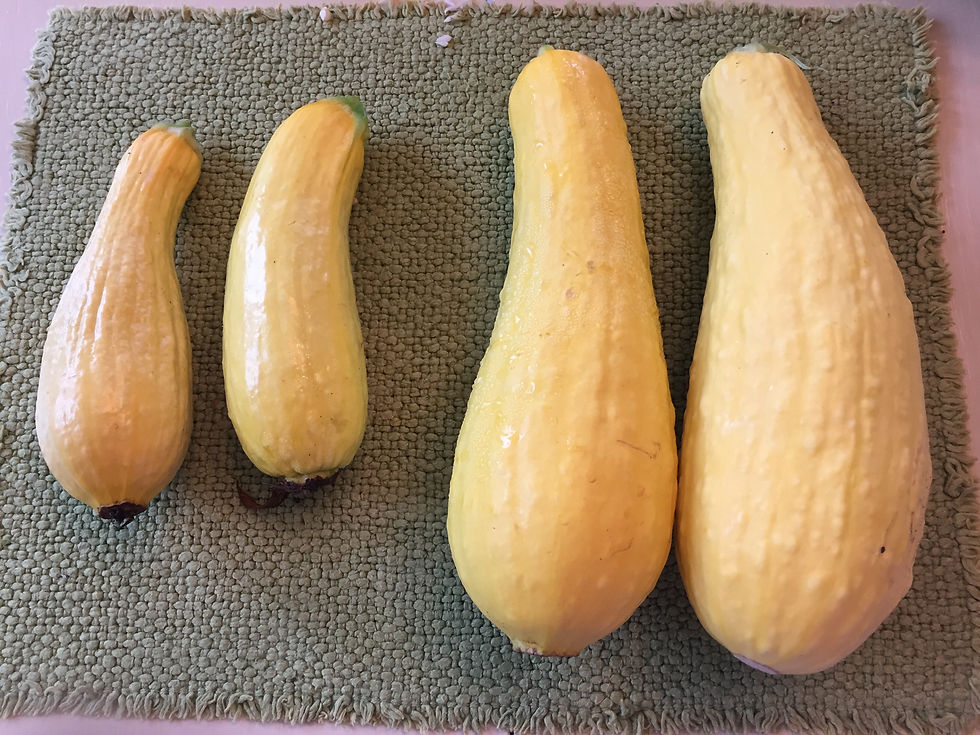Weed It and Reap: Nature’s Bounty
- andreasachs1
- Jul 19, 2021
- 4 min read
By Victoria Rolfe
It’s here at last! In midsummer, a garden explodes with its lush offerings. What a joy to behold! Everywhere you look things are budding, flowering, growing and ripening. This is the garden you were dreaming of back in the winter months when you were perusing the seed catalogs, eyes wide with the glory of all those photos of vibrant flowers and luscious fruits and vegetables. Now you can start to fill your baskets with all that goodness.

You might think there is nothing to learn. Harvesting is harvesting, right? You just go out and pick. Well, believe it or not, there are a few tricks of the trade to pass on to you that will give you optimum success with your harvest.
It is often tempting, especially for new gardeners, to leave their crops on the plant to grow as big as possible before finally giving in to harvesting them, in the belief that they are getting more vegetable for their money this way. Believe it or not, exactly the opposite is true. The more you keep picking those tender young veggies, the more the plant will keep producing. When all is said and done, by the end of the season, your total yield for that crop will actually be more, pound for pound. And another bonus of picking small is that you get nice clean fruits with no big seeds to deal with when preparing and eating.

The biological explanation for this is that your plant is trying to fulfill its reproductive destiny. It wants to produce seeds to carry on its legacy to the next generation. When you let the fruit get too big it starts to produce its seeds and this actually sends a signal back to the plant to start shutting down production, as it has achieved its life goal. So, you will keep your plant producing more by picking those veggies before they get to their ultimate seed production size. This obviously works with plants that produce multiple fruits on one plant such as squash, cucumbers, beans, peas, etc. and not on single crop plants such as beets, carrots and onions, which produce their seeds via a flower at a later phase of development.
As for when and how to pick your other crops: Green leafy plants can be harvested at any time. You can pick off the individual leaves (take the outer bigger leaves, leaving the inner plant to continue to grow and produce more) but if you do, be sure to also pluck the entire stalk (which will take energy from the plant and rot if you leave it on there). In the case of lettuce especially you can even cut the entire plant off one inch from the ground and it will grow back.
Other plants will signal to you when they are ready. Carrots will begin to show you their orange “shoulders” above the ground, as if to say, “Come and get me.” Garlic leaves will begin to brown to let you know the bulb is ready beneath the ground. The green tops of onions will also turn brown and even fall over to signal their readiness. And beets are the best of all. They will literally pick themselves by coming up out of the ground. The other good news about beets is that you do not have to pick them as soon as they are ready. They will continue to grow and be just fine even at baseball size or larger.

Don’t forget to pick your flowers as well. The same dynamic goes for them, especially annuals. The more you pick, preventing them from producing seeds, the more they will continue to frantically produce flowers. So bring in plenty of bouquets of zinnias and other flowers to enjoy! Your plants will make more.

Now I bid you goodbye for this month, wishing you a lovely, scrumptious, abundant crop as you quite literally enjoy the fruits of your labor. Happy, healthy gardening and eating!


Victoria Rolfe has had a love of gardening all her life, from the time she was a tiny child coveting the daffodils growing in her neighbor’s yard (and wondering why she couldn’t have them in her own), to her teenage years when she took her pot experimentation in a different direction by growing the seeds she extracted from the bag into a beautiful marijuana plant on her bedroom windowsill. She went on in her adult years to feed her family by growing a huge and bountiful vegetable garden, as well as beautifying her three-acre property with an array of ornamental trees, bushes and flowers in the magnificent Hudson Valley region of New York.
Victoria learned a great deal in the process of all this plant experimentation. She then added to that knowledge by taking courses with the Cornell Cooperative Extension to become a Master Gardener Volunteer. In her volunteer capacity, she helps to educate the public on gardening through classes and information booths, most notably at the Dutchess County N.Y. Fair each August. Throughout the summer months, Victoria is most likely to be found among the weeds, either in her own garden or those of others who actually pay her to play in their dirt and do the thing she loves best, delight in the magical world of gardening.
Victoria is not only a gardening aficionado; she is also passionate about helping people live a better life on less money. Visit her website and blog at brightfuture2budget4.weebly.com, or email her at brightfuture2budget4@gmail.com.
Comments